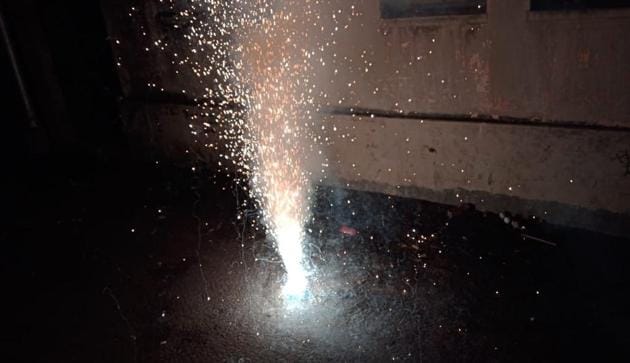Diwali night air quality levels in Kolkata reaches frightful levels
A thick haze hung in the air over the entire city, especially in areas adjoining E M Bypass, Ballygunge, Alipore, Kasba, Gariahat, Jadavpur, Golf Green, Ultadanga and Dum Dum.
The air quality of Kolkata recorded on Diwali night was so bad that it went far beyond the index of categorisation followed on the website of the American consulate in the city.

According to the consulate website, the presence of PM2.5 - the smallest, invisible and, therefore, most dangerous, particulate matter suspended in air - reached 624 ug/m3 at 12 midnight on November 7. According to the website, if the level is between 301 and 500 “everyone should avoid all outdoor exertion” and anything above 500 is undefined by the index.
The measurement is done by a device installed at the consulate’s office in south Kolkata.
According to the National Ambient Air Quality Standards, the permissible limit of PM2.5 is 60 ug/m3.
Moreover, the two-hour window stipulated by the apex court was brazenly flouted all over Kolkata. While it was relatively quiet in the early evening, the noise levels from crackers kept rising as the evening progressed and continued well beyond the 10 pm deadline.
A thick haze hung in the air over the entire city, especially in areas adjoining E M Bypass, Ballygunge, Alipore, Kasba, Gariahat, Jadavpur, Golf Green, Ultadanga and Dum Dum.
“We have failed as campaigners for protection of environment. The administration has failed to enforce the court’s guideline. About 1-2% people put paid to all the efforts,” rued green activist Subhas Dutta.
Naba Dutta, the secretary of environment activist group Subuj Sangha, said that he will compile all the related figures and move court to highlight how the Supreme Court’s guideline was violated.
Chairman of West Bengal Pollution Control Board (WBPCB), Kalyan Rudra feels that a more intense campaign is necessary to make people aware of the hazards caused by smoke from fire crackers. “Due to the cloudy weather on Wednesday, slow wind speed added to the trouble,” said Rudra.
During the entire day on Wednesday, the PM2.5 levels remained many times above the safety levels. According to the measuring station at Victoria Memorial Hall, PM2.5 levels stood at 174.31 ug/m3 at 10 pm. According to the device installed unit at Rabindra Bharati University the level stood at 327.77 ug/m3.
According to WBPCB officials, last year on Diwali night the PM2.5 level was about 100 ug/m3 at 10 pm and it rose close to 150 ug/m3 at midnight.
However, an expert cautioned against a strict comparison between this year’s levels and those recorded last year.
“Last year, there were rains and this year there was a cloud cover. It gives rise to a situation where last year’s reading would be far lower than what would have been under normal conditions. This year, it was higher due to the clouds and lack of wind. Therefore, there would be abnormal difference between the two readings,” said Dr Dipankar Saha, scientist and divisional head, air lab, Central Pollution Control Board.
In Kolkata, Sudipta Bhattacharjee of Saviours and Friend of Environment, an NGO working on pollution matters, measured PM2.5 levels in the city on November 6 (Kali Puja) and 7 (Diwali).
On November 7, he found it at 457 ug/m3 near Phulbagan, Bangur Avenue in the northern fringes of the city. The minimum level was near Dum Dum at 203 ug/m3.
“The effects were found on Thursday morning too. The PM2.5 level was at 177 ug/m3 between 6 and 7:30 am in the areas near Phulbagan, Bangur Avenue, where the worst readings were found on Wednesday evening,” said Bhattacharjee.
On November 6 (Kali Puja), he found the level at 149 ug/m3 (around 6:50 pm near Salt Lake stadium), the lowest that he recorded, while the worst was at 426 ug/m3 (at 8:30 pm near Ultadanga). Both areas are in the north eastern fringes.
According to data collected at the control room of Kolkata Police, till midnight of November 7 police received 98 complaints against 161 last year.
Till midnight, a total of 213 persons were arrested by Kolkata Police. By morning, the figure rose to about 550.






